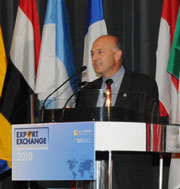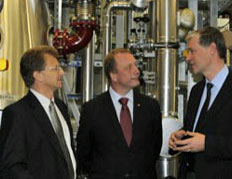Brazil’s largest state-owned energy company made another play today to become a world leader in biofuels. Petrobras announced a $1.23 billion deal with Tereos International’s Brazilian Branch, Acucar Guarani, to supply up to 2.2 billion litres of sugarcane ethanol to Petrobras’ fuel distribution subsidiary, BR, over the next four years.
Petrobras said in a statement tod![]() ay, “The contract ensures commitment in the supply to BR, access for Guarani to BR’s distribution system for part of its hydrated and anhydrous ethanol production, besides greater synergy between production, marketability and logistics.”
ay, “The contract ensures commitment in the supply to BR, access for Guarani to BR’s distribution system for part of its hydrated and anhydrous ethanol production, besides greater synergy between production, marketability and logistics.”
Petrobras has made several strategic moves in just the past few months including partnerships with Novozymes and KL Energy to develop second generation ethanol from sugarcane bagasse. In addition, the Company is converting several of its gas turbines to run on ethanol, and in other news an ethanol pipeline has received environmental permits.
Brazil is the second largest global producer of ethanol and is preparing to double its ethanol output over the next decade to meet the growing global demand for renewable fuels.





 Dr. Phillip Smith, a nutritionist with Tyson Foods, spoke at the recent
Dr. Phillip Smith, a nutritionist with Tyson Foods, spoke at the recent  South Dakota State University Extension swine specialist Dr. Robert Thaler talked about the use of DDGS in hogs and how it helps supply phosphorus in the diet. “Phosphorus supplementation to the diet is very expensive,” he said. “The cool thing is that the phosphorus in DDGS is highly available. So, if you’re replacing dical or monocal with phosphorus coming from DDGS, you’re going to have less phosphorus in the manure, it will probably be cheaper and plus, you’re going to have less environmental problems.”
South Dakota State University Extension swine specialist Dr. Robert Thaler talked about the use of DDGS in hogs and how it helps supply phosphorus in the diet. “Phosphorus supplementation to the diet is very expensive,” he said. “The cool thing is that the phosphorus in DDGS is highly available. So, if you’re replacing dical or monocal with phosphorus coming from DDGS, you’re going to have less phosphorus in the manure, it will probably be cheaper and plus, you’re going to have less environmental problems.”
 “Weyland represents an interesting and robust next generation biofuel technology that can use several types of feedstock. Together we are passing a historic milestone towards industrialization of this low carbon renewable fuel production. Today we are very excited with the progress and are looking forward to see the next achievements,” said Guntis Aboltins-Abolins, Head of the Future Fuel unit at Statoil, which contributed substantially to the funding of the pilot plant.
“Weyland represents an interesting and robust next generation biofuel technology that can use several types of feedstock. Together we are passing a historic milestone towards industrialization of this low carbon renewable fuel production. Today we are very excited with the progress and are looking forward to see the next achievements,” said Guntis Aboltins-Abolins, Head of the Future Fuel unit at Statoil, which contributed substantially to the funding of the pilot plant.

